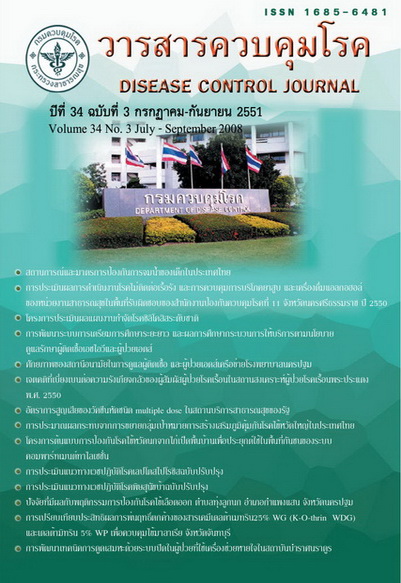Wastage of Multi-dose Measles Vaccine Survey in Public Health Facilities
Keywords:
Wastage rate of multidose vaccine, Public health facilitiesAbstract
The objective of this study was to estimate the wastage rate of measles and other vaccines in multiple dose vials and compared cost per dose of measles vaccine in single dose - vial and DTP-HB vaccines in 2 dose-vials with those in 10 dose-vials. The data collected were doses of vaccine used and number of vaccinees of all facilities under the 2005 DTP-HB expansion project, as reported monthly in the vaccine requisition form. Data were available from 850 facilities in 7 out of 12 provinces under the 2005 DTP-HB project. Measles vaccine in 10 dose-vial had average wastage of 57.1% (57.7% in health centre, 54.5% in < 30-bed hospital, 42.1% in > 60-bed hospital), more than 2 times over the WHO recommended wastage rate. Other vaccines in 10 or 20 dose- vial e.g. DTP, OPV, dT and DTP-HB had average wastage of 34.1, 45.0, 47.7, and 38.7% respectively. Vaccines in 2 dose-vial e.g. HB and JE had wastage of 15.6 and 17.3%. The cost per dose of measles vaccine in 10 dose-vial with 57.1 % wastage was 37.30 bahts, that was 0.4-0.6 time of cost of single dose vial measles vaccine in the market. If the EPI decides to replace measles in children age 9-12 month with MMR vaccine, use of single dose vial MMR vaccine with 5% wastage instead of 10 dose-vial with 57% wastage would be a cost saving (around 52 million bahts per year). Also, for the nationwide expansion of DTP-HB vaccine, the procurement of DTP-HB vaccine in 2 dose-vial with 15 % wastage instead of 10 dose-vial with 38.7 % wastage would save 15 million bahts a year. This study suggested that vaccine wastage rate in Thailand was much higher than those recommended by WHO. Expensive vaccines should be procured in 1 or 2 dose-vial. Vaccine wastage should be monitored and if possible, be minimized. This survey covered only opened vial wastage that is only one part of the total wastage. For efficient procurement, in order to prevent over stock or out of stock, a study to estimate unopened vial wastage is needed.
Downloads
References
2. World Health Organization. Technet Consultation : Copenhagen,16-20 March, 1998. Issues in developing estimates of vaccine requirements for national EPI programmes. 1998. WHO document WHO/EP/TECHNET.98/WP.10
3. Guidelines on Country Proposals for Support to Immunization Services and New and Under-used Vaccines. Available from :http://202.54.104.236/intranet/eip/immunizationmanager/pages/alpha.htm ,cited on: 2006 December
4. คู่มือการบริหารจัดการวัคซีนและระบบลูกโซ่ความเย็น พ.ศ. 2547. สำนักโรคติดต่อทั่วไป กรมควบคุมโรค กระทรวงสาธารณสุข. พิมพ์ครั้งที่ 1 โรงพิมพ์การศาสนา สำนักงานพระพุทธศาสนาแห่งชาติ; 2547. 46.
5. กลุ่มเภสัชกรรม สำนักโรคติดต่อทั่วไป กรมควบคุม
Downloads
Published
How to Cite
Issue
Section
License
Articles published in the Disease Control Journal are considered as academic work, research or analysis of the personal opinion of the authors, not the opinion of the Thailand Department of Disease Control or editorial team. The authors must be responsible for their articles.






